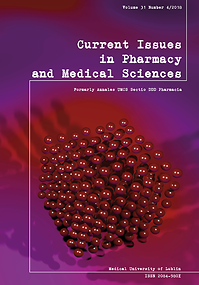Chemical Composition, Toxicity, and Acaricidal Activity of Eucalyptus Globulus Essential Oil from Algeria
DOI:
https://doi.org/10.1515/cipms-2018-0017Keywords:
Eucalyptus globulus, leaf essential oil, thymol, toxicity, Varroa destructorAbstract
The study was aimed at determining the chemical composition, toxicity effect and field varroacidal efficacy of the essential oil distilled from the leaf of Eucalyptus globulus (Eg) grown in Algeria. Brine shrimp lethality (BSL) assay and bee hives infected by Varroa destructor were used to assess the toxicity and acaricidal effect, respectively. Steam distillation of leaves yielded 0.93 % (v/w) of essential oil (EO). GC/MS Analysis revealed 39 compounds, essentially oxygenated monoterpenes (86.01%). The main constituents of the oil were 1,8-cineole (78.45 %), o-cymene (2.18 %), isopinocarveole (1.74 %), α-pinene (1.69 %), pinocarvone (1.34%) and veridiflorol (1.31%). The BSL assay revealed a highly toxic value of LC50 (67.55 μg/mL). Furthermore, field efficacy testing on bee hives infected with Varroa destructor has confirmed the effectiveness of Eucalyptus globulus essential oil (EgEO) or thymol as varroacidal agents. Moreover, a EgEO + thymol association was more effective than EgEO or thymol alone. Finally, the use of EgEO + thymol may constitute a viable alternative to the thymol-based commercial treatment
References
1. Kluser S, Neumann P, Chauzat MP, Pettis JS. Global honey bee colony disorder and other threats to insect pollinators. UNEP Emerging Issues 1, Kenya; 2002:1-12.
2. Labeste L. Protocole de traitement aux huiles essentielles – activité acaricide sur le Varroa. Apisevices-Galerie Virtuelles Apicoles, France; 2013.
3. Ghomari FN, Kaouache B, Arous A, Cherchali S. Effet de traitement par fumigation du thym (Thymus vulgaris) sur le Varroa destructor agent de la varroase des abeilles. Revue Nature et Technologie: B-Sci Agro et Bio. 2014;10:34-8.
4. Adjlane N, El Ounass J, Haddad N. Situation de l’apiculture en Algérie: facteurs menaçants la survie de colonies d’abeilles locales Apis mellifera Intermissa. J. Arthropod-Born.Dis. 2016;10(4):501-8.
5. Bogdanov S, Charriere JD, Imdorf A, Kilchenmann V. Determination of residues in honey after treatment with formic and oxalic acid under field conditions. Apido. 2002;33:399-9.
6. Umpiérrez ML, Santos E, González A, Rossini C. Plant essential oils as potential control agents of varroatosis. Phytochem Rev. 2011;10(2):227-4.
7. Abdelwahab TE, Ebadah MA, Zidan EW, Evaluation of some volatile plant oils and maurik against Varroa destructor in honey bee colonies. J of Appl Sci Res. 2006;2(8):514-21.
8. Ghasemi V, Moharramipour S, Tahmasbi G. Biological activity of some plant EOs against Varroa destructor (Acari: Varroidae), an ectoparasitic mite of Apis mellifera (Hymenoptera: Apidae). Exp Appl Acarol. 2011;55:147-54.
9. Mahmoud R, Asad S, Raja S, UL Moshina A, Wagchoure ES, Sarwar G, et al. Control of Varroa destructor (Acari: Varroidae) in Apis mellifera. (Hymenoptera: Apidae) by using Plant Oils and Extract.Pakistan. J. Zool 2014;46(3):609-15.
10. Habbi-Cherif Aisssa. Etude de la dynamique du parasite Varroa destructor de l’abeille domestique (Apis mellifera) et évaluation de l’efficacité de quelques huiles essentielles dans la lutte contre ce parasite. Mémoire de Magister, Université MouloudMameri,TiziOuzou, Algria; 2014.
11. Coffey MF, Breen J.Efficacy of ApilifeVar® and Thymovar® against Varroa destructor as an autumn treatment in a cool climate. J of Apicu Res. 2013;52(5):210-18.
12. Shahrouzi R. La varroatose en Iran. Abeilles & cie, 2004;103:24-25.
13. Rosenkranz P, Aumeier P, Ziegelmann B. Biology and control of Varroa destructor. J of Invert Patho. 2010;103:96-119.
14. Shengping PJYQQ, Lihua LCW. Study of the niche transition of lesser Asian mite (Tropilaelapsclareae) in honey bee colony just after infection desynchronisation of larger varroa mite (Varroa destructor). Apicul of China. 2011.
15. Boulekbache-Makhlouf L, Meudec E, Chibane M, Mazauric JP, Cheynier V, Slimani S, et al. Analysis of phenolic compounds in fruit of Eucalyptus globulus cultivated in Algeria by high-performance liquid chromatography diode array detection mass spectrometry. J. Agric. FoodChem. 2010;58:12615-24.
16. Cermelli, A. Fabio, G. Fabio, P. Quaglio,P. Effect of Eucalyptus essential oil on respiratory bacteria and viruses. Current Microbiology. 2008;56(1),89-92.
17. Boukhatem MN, Amine FM, Kameli A, Saidi F, Walid KS, Bouziane M. Quality assessment of the essential oil from Eucalyptus globulus Labill of Blida (Algeria) origin. Int Let Chem Phys Astro. 2014;17:303-15.
18. Batish DR, Singh HP, KohliRK, Kaur S. Eucalyptus essential oil as a natural pesticide. Forest Ecol. Manag. 2008;256:2166-74.
19. Goldbeck J, do Nascimento JE, Jacob RG, Fiorentinia ÂM, da Silva WP. Bioactivity of essential oils from Eucalyptus globulus and Eucalyptus urograndis against planktonic cells and biofilms of Streptococcus mutans. Ind Crops Prod. 2014;60:304-9.
Downloads
Published
Issue
Section
License
Copyright (c) 2018 Authors

This work is licensed under a Creative Commons Attribution-NonCommercial-NoDerivatives 3.0 Unported License.


